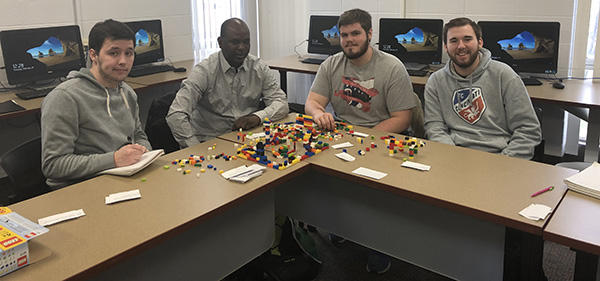Student and Teacher Testimonies

What Professors Say
Video Testimonies
What Students Say
Written Testimonies
Dylan Lawson, Health Information Technology Senior
When did you first learn about Agile?
I learned about Agile when taking CIT 214. It was an intro to database management course.
Once you learned about Agile, how did you connect that to your learning?
I like the idea of breaking down larger portions of work into smaller tasks, so I began doing that activity with most of my college assignments.
How long did it take to implement this into your coursework?
Breaking things down took some time as I didn't have the discipline to schedule out when and what I should be working on. In about two college semesters, things started to get easier and that was when I felt like I implemented Agile into my coursework.
Why did you choose to utilize Agile in your learning?
It seemed to me that Agile can help in individual work as well as teamwork. Being able to organize yourself and a team with one methodology sounded like a resourceful way of being productive.
What are the major benefits, in your opinion, of Agile in terms of how it helps you learn?
One major benefit that I can think of is that Agile tries to promote teamwork and understanding inside of a project. It's understandable that when a group starts a project, it can be a little awkward as you may not know the people around you. As the project develops, trust forms and the work becomes more comfortable to complete. This in turn makes learning Agile fun as it can help you connect with other students in the class.
What are some possible drawbacks of Agile?
In a school setting, Agile does not always work with everyone as schedules for team members can conflict. Not everyone can complete a fair share of work and some members will need to take a larger workload than others. This can make the members who do more work unintentionally silo information.
In a specific setting, if a member who can take on the bulk of the work does the most coding for a program, they might find difficulty in explaining the way that the program was coded to his/her other members. Ultimately, that one member will need to continue to code the program on their own because explaining the program to their teammates will take too much time and impede progress.
What is your favorite or most useful Agile technique or exercise and why?
I enjoyed creating story cards for projects and then categorizing what story card should be under Must, Should, Could, or Won't.
This technique helps personalize and put a face on the project. You can get an idea of perspectives of different stakeholders and that motivates me to work more efficiently on the project.
In your experience, how easy/hard is it to switch to using the Agile way?
In my experience, it is fairly difficult to adhere to Agile. On paper it is a simple concept, but in practice, actually using Agile is taking some time to get used to.
In what ways do you see Agile methods/techniques help a student with their natural learning?
Agile promotes trust and understanding in groups. Group work can sometimes be a nervous experience for a large portion of students and I think Agile can help reduce anxiety in group work once everyone knows each other.
In what situations in your coursework has Agile proven to be most useful?
Using Agile has given me more confidence during stand-ups and iteration presentations. Once of the best ways to get better at something is to just keep repeating the same action. Agile gives many opportunities to stand-up and speak to the class/client. Being able to speak clearly and coherently is a very desired trait that many employers look for. So the more that I speak during stand-ups and iteration presentations, the better at speaking I can become which can help me secure a job position.
Do you have any feedback for staff/faculty/students who are looking to implement Agile for the first time?
I would say that even though Agile can be useful, I wouldn't completely invest into it. In other words, don't fully commit 100% to Agile. It may have great practices, but Agile does not designate leaders.
In a class, if students are just given the responsibility to work on a project without leadership they may not know where to start or end. Having occasional support and understanding for what they should do for a project.
Justin Stapleton, Computer Information Technology Senior
When did you first learn about Agile?
I first learned about Agile 2 semesters ago in CIT 376 and in CIT 348 when we used activities like stand-ups and retrospectives.
Once you learned about Agile, how did you connect that to your teaching?
I really found that Agile was a great way for students and professors to ensure they are getting the correct content and knowledge out of the class. Agile allows for a stop and reflect phase, which ensures student learning.
How long did it take to implement this into your classroom?
I do not have my own classroom, but one way I have used Agile outside of school is utilizing things like a Trello board to track what all I need to get done, to ensure I have completed the necessary tasks at home.
What are some possible drawbacks of Agile?
I think the main drawback of Agile is that it is heavily reliant on teamwork, and if a team does not work well or one member is slacking, it can throw off the entire team.
What is your favorite or most useful Agile technique or exercise?
I really like the Agile retrospectives and standups. I think they provide valuable insight into how the team is doing, and this ensures progress is being made.
In your experience, how easy/hard is it to switch to teaching in an Agile way?
I think the most difficult part of Agile is learning to work in teams on everything.
Do you have any feedback for staff/faculty who are looking to implement Agile for the first time?
I think that any staff member who implements Agile in their classroom will see the benefits early on. The use of standups and retrospectives alone help the professors change things, as needed, so that students continue learning.
Bambi Gray, Computer Information Technology Junior
When did you first learn about Agile?
I first learned about Agile in CIT 276 (IT System Design and Lifecycle Management).
Once you learned about Agile, how did you connect that to your teaching?
Agile offers a method that allows for students to complete task and then top and review their steps/process with the professors. This helps students receive direct feedback on their process.
How long did it take to implement this into your classroom?
As a student I utilize Agile to track and manage my assignments.
What are the major benefits, in your opinion, of Agile in terms of how it helps you teach? How it helps students learn?
As a student, the constant feedback and retrospectives of Agile helps me learn. Receiving feedback helps me address areas that I am struggling in at that point in time vs. wanting for large test to learn my weaknesses. Retrospectives are also helpful as they offer the opportunity to identify issues.
What are some possible drawbacks of Agile?
A drawback of Agile is the reliance the process has on all teamwork.
What is your favorite or most useful Agile technique or exercise?
My favorite exercises of Agile are standups and showcases. I think both of these are very helpful to the team members. Standup provides clarity on where the overall project is and showcases allow the teams more clarification on where the project needs to go.
Do you have any feedback for staff/faculty who are looking to implement Agile for the first time?
Find the techniques and exercises that work best for you.
Alex Koontz, Computer Information Technology Senior
When did you first learn about Agile?
I first learned about Agile in CIT 214 and CIT 276 within the same semester. This was roughly my sophomore year of college.
Once you learned about Agile, how did you connect that to your teaching?
Agile reinforces going over what you've done, and making the necessary adjustments so the bad things happening if any don't keep happening and there is so much value in that. Agile made me start reflecting on what I had previously done and ways I can improve what I had done for the next time.
How long did it take to implement this into your classroom?
Parts of the Agile way really have stuck with me, especially in terms of reflection. Though I don't have a classroom of my own, I really started sot see aspects of Agile come out in other areas of my work almost immediately after really digging into CIT 205.
What are the major benefits, in your opinion, of Agile in terms of how it helps you teach?
Being able to stop, look at what you have, assess what needs to be done and make the necessary changes. This is built into the Agile process with the retrospectives, iterations, standups, etc. where all these things have to occur within Agile.
What are some possible drawbacks of Agile?
It breaks the chain of command so to speak, depending on the culture already in place this could cause huge issues
What is your favorite or most useful Agile technique or exercise?
The retrospectives.
Do you have any feedback for staff/faculty who are looking to implement Agile for the first time.
Use what works for you.
Curtis New, Computer Information Technology Sophomore
When did you first learn about Agile?
January 2019 in my CIT 205 class.
Once you learned about Agile, how did you connect that to your learning?
I connected Agile to my learning by implementing the Agile way of thinking. Doing this helps me organize my workload and how to manage my time efficiently.
How long did it take to implement this into your classroom?
It did not take long since we practiced using Agile and learned about the methods on how Agile is implemented and used.
What are the major benefits, in your opinion, of Agile in terms of how it helps you teach? How it helps students learn?
The showcases and retrospectives help us learn a lot about what else we have to do for our project and what we have done well so far in the project.
What are some possible drawbacks of Agile? In terms of implementation maybe?
It is difficult to make sure everyone is on the same page in terms of communication since there are several teams working.
What is your favorite or most useful Agile technique or exercise?
Agile provides a lot of useful techniques. My favorite is how they try to reduce the stigma that meetings have in our heads. They try and reshape how we think about meetings by changing them to stand-ups and making them a little less intimidating and formal.
In your experience, how easy/hard is it to switch to teaching in an Agile way?
If you want to switch to Agile you must incorporate everything Agile has to offer. You cannot pick and choose which parts of Agile you want to implement and then leave out the portions that you do not like. Agile is a package deal and everything in that must be incorporated to become Agile.
In what ways do you see Agile methods/techniques help a student with their natural learning?
Just from being in an Agile environment for about 4 months now we can see most of our classmates change to Agile learning. The main technique that everyone uses is the fist of five and the stand-ups.
In what situations in your classroom has Agile proven to be most useful?
Retrospectives and stand-ups provide us with beneficial information on how we are moving along as a team.
Do you have any feedback for staff/faculty who are looking to implement Agile for the first time?
Implement Agile as a full measure. You have to take everything Agile has to offer and run with it. If you pick and choose which parts to implement while leaving others out then you will not experience all that Agile has to offer.
Ryan Bell, Computer Information Technology Senior
When did you first learn about Agile?
I first learned Agile in my CIT 276 class last fall. There we had to do different types of IT management and work as groups in order to get work done while using a different way to organize said work.
One you learned about Agile, how did you connect that to your learning?
For me it was a bit of an easy change. I always would break down my work into smaller bits and slowly work on it. I would also time myself on work to make sure that not only did the work but make sure i didn't have 50 items due on one day.
How long did it take to implement this into your homework?
Like I said before, I try to break up my work so not only is it easier but also helps with planning out my assignment. I also use it in groups when we need to break up work and make sure that not only everyone does their part, but have everyone do what they are best at as well.
Why did you choose to utilize Agile in your work?
Mostly because it was very similar to what I did already when it came to individual work or group work.
What are the major benefits, in your opinion, of Agile in terms of how it helps you learn?
Honestly one of the major benefits is breaking down the work and making it into more easily managed pieces which helps when it comes to big assignments making them easier and not as scary to deal with.
What are some possible drawbacks of Agile?
When people either do no work or too much work, the reason for this is if one person is doing nothing or close to nothing then it forces everyone else to pick up their slack. And for when one person takes up a lot of work it makes everyone else look like they are doing nothing but they may not be the case, that one person may have a bunch of extra time compared to the others.
What is your favorite or most useful Agile technique or exercise?
I would say breaking down work into smaller bits. Mostly because it makes assignments easier to work with and more manageable.
In your experience, how easy/hard is it to switch to learning in an Agile way?
For me it was easy to switch to Agile since many of the things it did were already things I already did when it came to assignments or group work.
In what ways do you see Agile methods/techniques help you with your natural learning?
I think it helps take stress off things, by breaking down the work and managing my time. It helps make sure that not only do I do my work, but also makes sure that the work is getting done on time.
IN what situations in your experience has Agile proven to be most useful?
Mostly when it comes to group projects since it is an easier way to work on stuff in groups.
Do you have any feedback for staff/faculty who are looking to implement Agile for the first time?
That is something worth considering especially with large assignments and group work. Also the standups and retrospectives can be very helpful when it comes to getting people focused on a goal.
Roshanak Basty, Computer Information Technology Junior
When did you first learn about Agile?
I was first introduced to Agile in CIT 276 HA. We were exposed to the basic concepts and methodologies of Agile and what principles it has and how it is being used as a project management approach.
Once you learned about Agile, how did you connect that to your teaching?
Since our exposure to Agile was short and limited to the basic principles and practices, I did not devote more time to know about Agile or use it in my learning experiences. This was until I entered CIT 205 which I got plenty time and opportunities to use Agile and its principles in my classes and create an interactive, flexible and Agile environment for my teams and myself.
How long did it take to implement this into your classroom/learning?
I do not have a classroom now. However, if given the chance to implement it in class, would depend on the major, subject, and content that would be taught. Agile is an approach that needs to be experimented to see if it is applicable and if the classroom has the potential to practice Agile or not.
Why did you choose to utilize Agile in your classroom/learning?
Choosing to utilize Agile would suit best in software development and CIT, CSE courses which include assignments and projects that need to be completed in groups and in certain amount of time. Even if the full concept of Agile may not be fully implemented in a classroom, every instructor or student can look at its methodologies and apply those they like such as running standups, having retrospectives and so forth.
What are the major benefits, in your opinion, of Agile in terms of how it helps you learn?
In terms of learning, Agile, as its name presents, makes students agile and more efficient in completing their assignments, increase their learning pace and impact their learning outcomes in a constructive way. However, Agile is something that requires practice and time to understand, become comfortable to work with and implement in different levels of one's work, life and studies.
What are some possible drawbacks of Agile? In terms of implementation maybe?
Agile contributes heavily face-to-face interaction with lots of stakeholders and people. As a result, it works best in small to medium sized projects and businesses. Implementing it in enterprises or in large projects, can become cumbersome due to the time it consumes to receive lots of feedback, communicate back and forth, reflect on them and apply the necessary changes.
Because requirements for software are clarified just in time for development, documentation is less detailed. This means that when new members join the team, they do not know the details about certain features or how they need to perform. This creates misunderstandings and difficulties.
Since Agile contributes a different culture in how people interact, it can cause some conflict in business and learning environments where hierarchical culture is in demand or required. As a result, it can break the chain of command that can result in internal complications.
Even though Agile contributes a flexible working schedule but some projects also mention that it can lead to an infinite project timeline because no definite project outcome may be produced in the end. This can lead to scope creep or lead teams off track. If the project falls off track it would become difficult to measure the quality of the objectives and performances.
What is your favorite or most useful Agile technique or exercise? Why?
Creating user stories was an amazing experience because it helps you identify the possible features and items you wish to create for your project. It resembles a brainstorming process which you list all you have in mind and then choose those best and most important ones with prioritization and estimation approaches. Another thing I loved most about Agile is that constant communication helps you mitigate risk and errors which can save a lot in long run which can be beneficial.
In your experience, how easy/hard is it to switch to teaching in an Agile way?
It is rather difficult and challenging to switch to an Agile way of thinking and working. When switching to Agile, one must evaluate if they have the potential to go Agile, how much the methodologies and principles adhere to their work style and if they are willing to go fully Agile or not. Before implementing Agile in much broader way such as a classroom, one must test to see if they can accomplish Agile on an individual level.
Then, it would be good to practice with a small group of colleagues to complete works and manage one's working environment. If successful, one can run it in a broader environment such as work place with more groups involved or in a classroom. Nevertheless, caution needs to be practiced because if Agile has worked in the past experiences, it does not necessarily mean that it might work all the time.
Reflection and running evaluations are good means to measure how successfully Agile was when it was implemented in a classroom, or workplace. If it has not worked to one's expectations or standards, one must go back and reflect the cause of failure. If they can be fixed then plans can be devised to address and respond to those issues, otherwise, the least that can be done is to identify what things have gone well and continue to use them in the future as well. Overall, Agile requires time and practice and it cannot be mastered soon or easily. The important thing is to learn from past experiences and improve oneself to increase productivity and working outcome.
In what ways do you see Agile methods/techniques help a student with their natural learning?
Agile exposes students to new mindsets and perspectives. By putting them out of their comfort zones on many levels, it helps them build their confidence, resilience and improve their interpersonal skills. Agile is an approach that contains lots of trails and errors that can help a student grow and increase their innovation and productivity. They would be exposed to team-work and be able to manage collaborations and communications with different perspectives and broaden their horizon.
In what situations in your classroom has Agile proven to be most useful?
It provided us a good opportunity to practice different levels and means of communication, internal teams, across teams and with customer and stakeholders. This interactivity with lots of people helps one know how to improve their communication skills. Even though it may be time consuming at first but once you find the right people and learn to ask the right questions, your learning pace increases.
Do you have any feedback for staff/faculty who are looking to implement Agile for the first time?
If staff and faculty wish to implement Agile, it would be good to practice that on an individual level to see if they have the potentials and preparations to go Agile or not. Then they can gradually increase their scope of work into classrooms by exposing students to Agile through very small and manageable assignments. In time, when students have learned to manage small assignments using Agile, they can expand their use into larger assignments and projects with greater number of groups. I recommend them to give themselves and their students time and patience to see if Agile is the best approach for them or not.




